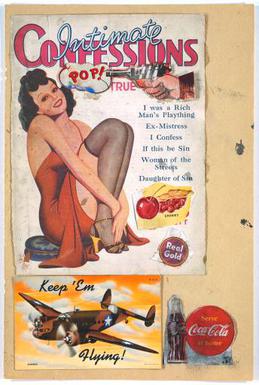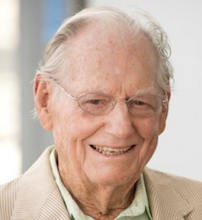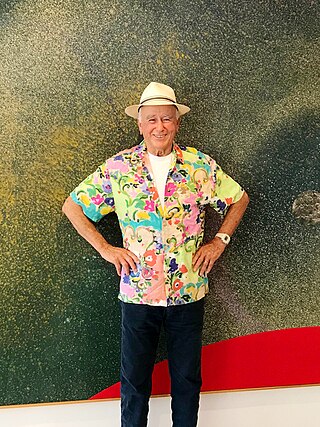
Roy Fox Lichtenstein was an American pop artist. He rose to prominence in the 1960s through pieces which were inspired by popular advertising and the comic book style. Much of his work explores the relationship between fine art, advertising, and consumerism.

Pop art is an art movement that emerged in the United Kingdom and the United States during the mid- to late-1950s. The movement presented a challenge to traditions of fine art by including imagery from popular and mass culture, such as advertising, comic books and mundane mass-produced objects. One of its aims is to use images of popular culture in art, emphasizing the banal or kitschy elements of any culture, most often through the use of irony. It is also associated with the artists' use of mechanical means of reproduction or rendering techniques. In pop art, material is sometimes visually removed from its known context, isolated, or combined with unrelated material.

The San Francisco Museum of Modern Art (SFMOMA) is a modern and contemporary art museum and nonprofit organization located in San Francisco, California. SFMOMA was the first museum on the West Coast devoted solely to 20th-century art, and has built an internationally recognized collection with over 33,000 works of painting, sculpture, photography, architecture, design, and media arts. The collection is displayed in 170,000 square feet (16,000 m2) of exhibition space, making the museum one of the largest in the United States overall, and one of the largest in the world for modern and contemporary art. In 2024, SFMOMA was ranked 14th in the Washington Post's list of the best art museums in the U.S.

Wayne Thiebaud was an American painter known for his colorful works depicting commonplace objects—pies, cakes, lipsticks, paint cans, ice cream cones, pastries, and hot dogs—as well as for his landscapes and figure paintings. Thiebaud is regarded as one of the United States' most beloved and recognizable artists. Thiebaud is associated with the pop art movement because of his interest in objects of mass culture, although his early works, executed during the fifties and sixties, slightly predate the works of the classic pop artists. Thiebaud used heavy pigment and exaggerated colors to depict his subjects, and the well-defined shadows characteristic of advertisements were almost always included in his work.

Jim Dine is an American artist. Dine's work includes painting, drawing, printmaking, sculpture and photography; his early works encompassed assemblage and happenings, while in recent years his poetry output, both in publications and readings, has increased.
Events from the year 1962 in art.

Edward Joseph Ruscha IV is an American artist associated with the pop art movement. He has worked in the media of painting, printmaking, drawing, photography, and film. He is also noted for creating several artist's books. Ruscha lives and works in Culver City, California.

John Rivers Coplans was a British artist, art writer, curator, and museum director. A veteran of World War II and a photographer, he emigrated to the United States in 1960 and had many exhibitions in Europe and North America. He was on the founding editorial staff of Artforum from 1962 to 1971, and was Editor-in-Chief from 1972 to 1977.

The Gagosian Gallery is a modern and contemporary art gallery owned and directed by Larry Gagosian. The gallery exhibits some of the most well-known artists of the 20th and 21st centuries. As of 2024, Gagosian employs 300 people at 19 exhibition spaces – including New York City, London, Paris, Basel, Beverly Hills, San Francisco, Rome, Athens, Geneva, and Hong Kong – designed by architects such as Caruso St John, Richard Gluckman, Richard Meier, Jean Nouvel, and Annabelle Selldorf.

Campbell's Soup Cans is a work of art produced between November 1961 and June 1962 by the American artist Andy Warhol. It consists of thirty-two canvases, each measuring 20 inches (51 cm) in height × 16 inches (41 cm) in width and each consisting of a painting of a Campbell's Soup can—one of each of the canned soup varieties the company offered at the time. The works were Warhol's hand-painted depictions of printed imagery deriving from commercial products and popular culture and belong to the pop art movement.

Robert Dowd was an American artist, who also painted under the name Robert O'Dowd.
Phillip Hefferton was an American pop artist from Detroit, Michigan, known for his paintings of banknotes.
Joe Goode, is an American visual artist, known for his pop art paintings. Goode made a name for himself in Los Angeles, California, through his cloud imagery and milk bottle paintings which were associated with the Pop Art movement. The artist is also closely associated with Light and Space, a West Coast art movement of the early 1960s. He resides in Los Angeles, California.
Mara Devereux is an American artist.

The Ferus Gallery was a contemporary art gallery which operated from 1957 to 1966. In 1957, the gallery was located at 736-A North La Cienega Boulevard, Los Angeles in the U.S. state of California. In 1958, it was relocated across the street to 723 North La Cienega Boulevard where it remained until its closing in 1966.

Billy Al Bengston was an American visual artist and sculptor who lived and worked in Venice, California, and Honolulu, Hawaii. Bengston was probably best known for work he created that reflected California's "Kustom" car and motorcycle culture. He pioneered the use of sprayed layers of automobile lacquer in fine art and often used colors that were psychedelic and shapes that were mandala-like. ARTnews referred to Bengston as a "giant of Los Angeles's postwar art scene."
Jonathan Novak is an American art dealer.

Ten Dollar Bill is a 1956 proto-pop art lithographic drawing by Roy Lichtenstein. Considered to be a combination of Americana art and cubism, the work is referred to as the beginning of Lichtenstein's work on pop art. Twenty-five editions of the lithograph were made by Lichtenstein, which were exhibited at several galleries. The piece is based on the design for the ten-dollar bill and has influenced several of Lichtenstein's later works. The picture has received generally favorable reception from critics, and is considered to be one of the best artistic portrayals of currency.
Harold Moncreau Stevenson Jr. was an American painter known for his paintings of the male nude. He was a friend, a mentor, and an associate of Andy Warhol, and appeared in the Warhol film Heat.

Michael Maloney is a Los Angeles-based art appraiser and art dealer. He owned and operated the Michael Maloney Gallery in Santa Monica, California (1985–90) and Maloney Fine Art in Culver City, California (2006–16), and since 1998 has pursued a career as an art appraiser and private dealer in Los Angeles and New York.














